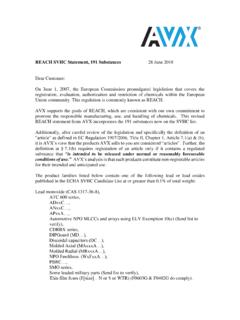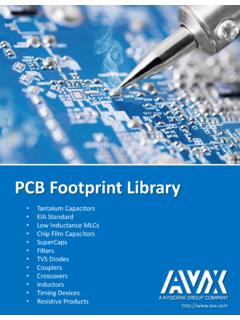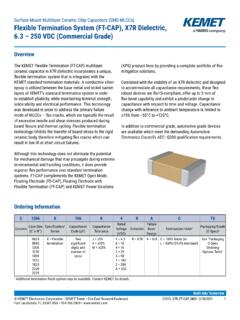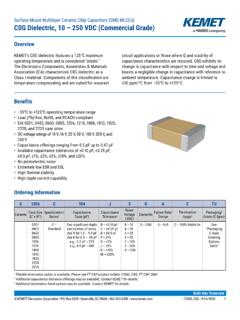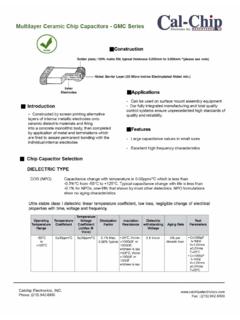Transcription of Cracks: The Hidden Defect - AVX Corporation
1 CRACKS: THE Hidden DEFECTby John MaxwellAVX CorporationAbstract:Cracks in ceramic chip capacitors can be introduced at any process step during surface mount shock has become a pat answer for all of these cracks, but about 75 to 80% originate fromother sources. These sources include pick and placemachine centering jaws, vacuum pick up bit, boarddepanelization, unwarping boards after soldering, testfixtures, connector insulation, final assembly, as well as defective components. Each source has a unique signature in the type of crack that it develops so thateach can be identified as the source of in ceramic surface mount technology (SMT)components limit assembly reliability and yields. Thesecracks manifest themselves as electrical defects: intermit-tent contact, variable resistance, loss of capacitance andexcessive leakage currents. Large visible cracks and theinsidious micro crack are usually blamed on the solderingprocess by component vendors and the components them-selves by the users.
2 The actual sources of cracks includeboth solder processing and to a lesser extent, defectivecomponents; but other very significant sources exist as can be introduced at any process step used tomanufacture an assembly. These sources include thermalshock by the soldering and cleaning processes, pick andplace machine centering jaws and vacuum pick up bit,board depanelization, unwarping boards after soldering,test fixtures, connector installation, final assembly, defec-tive or wrong value components and cracked or missingsolder joints due to board design. Many production areaswill have most if not all crack sources present so one mayobscure the others. Luckily each source of cracks has aunique signature such that even the type of pick and placemachine is easily Shock Thermal shock is the pat answer for all cracks but isresponsible only 20-25% of the time with the other sourcesof defects making up the balance. When thermal shock ispresent, it can easily obscure all other crack sources so anunderstanding is needed for each type of Defect to identifyand eliminate them.
3 Thermal shock is mechanical damagecaused by a structure s inability to absorb mechanicalstress caused by excessive changes of temperature in ashort period of time. This stress is caused by differences inCTE (coefficient of thermal expansion), T (thermal con-ductivity) and the rate of change of temperature. CTE and T are a function of the materials used in the component smanufacture and the rate of change of temperature isdependent on the soldering process. Thermal shock is acomplex issue that has been covered earlier in detail1, 2soonly an overview of those cracks is ceramic capacitors are sensitive to thermalshock due to device construction consisting of interleavedlayers of ceramic dielectric and metal electrodes withmetal terminations for electrical contact. This structurehas been described (See Figures 1 and 2)Figure 1. MLC StructureFigure 2. MLC Monolithic Structure WithoutTerminationTABLE ICTEs AND Ts OFCOMPONENT MATERIALSM aterialCTE (ppm/ C) T (W/m K)Alloy to Epoxy18-25 Lead Alloys 2734 CRACKS: THE Hidden DEFECTby John MaxwellAVX CorporationCompatible materials used in MLC manufacture havedifferences in CTE and T that cause internal the temperature rate of change is too great, thermalshock cracks occur.
4 These cracks are initiated where thestructure is weakest and mechanical stress is concentrat-ed. This is at or near the ceramic /termination interface inthe middle of the exposed termination. Mechanical stressis greatest at the corners where the chip is strongest butcracks tend to start where the structure is weakest. Whentemperature rates of change are excessive, as in uncon-trolled wave soldering, large visible U-shaped or thumb-nail surface cracks are 3. Stress Risers Caused by the Termination on theMLC BodyFigure 4. Extreme Thermal Shock Cracks in MLCsThermal shock has two manifestations, obvious visiblecracks (Figure 4) and the more insidious, invisible microcrack (Figure 5). The same forces are involved but on asmaller magnitude so smaller cracks are formed. Again itstarts in the middle of the exposed surface at or just underthe ceramic /termination interface and propagates slowlywith temperature changes or assembly flexure duringhandling.
5 In a matter of weeks a micro crack can propa-gate through the ceramic causing opens, intermittents orexcessive leakage currents, a time bomb due to processing(Figure 6).Figure 5. The Micro Crack LocationFigure 6. A Propagated Micro Crack After Power CyclingThermal shock cracks are always caused by impropersolder processing or cleaning. Wave soldering is thebiggest culprit because it has the highest heat transferrate (using liquid metal) and the largest temperaturechanges which cause both visible and micro cracks. Vaporphase soldering has the second highest heat transfer rateand temperature changes which can induce micro crackswhen inadequate preheat is used. Infrared (IR) reflow soldering has the lowest heat transfer rates and thermalshock is unheard of for this soldering technique. Assemblycleaning cannot be ignored because thermal shock canoccur during heating or cooling. An assembly should beallowed to cool to less than 6O C before it is subjected tothe cleaning and Place Machine DamagePick and place machine damage constitutes the largestsource of defects in a manufacturing environment defects are usually erroneously called ThermalShock Cracks sending both the vendor and manufactur-ing groups down the wrong path looking for a damage is caused by the centering jaws or vacuumpick up bit with the frequency of damage time and shiftdependent.
6 With the exception of gross damage, pick andplace machine cracks do not appear until after the part hasbeen subjected to the soldering process but are veryunique. These too are large, visible cracks and invisibleinternal damage that is also a processing time Pick-Up BitDamage or cracks caused by vacuum pick-up bits isstraightforward and obvious (Figure 7). It usually consistsof a crushed circular- or halfmoon-shaped area on theexposed surface of the chip and is usually quite rough withragged edges or can be a visible impression of the place-ment bit. Additionally the halfmoon or circular areas willmatch the bit diameter. Another manifestation of bit dam-age occurs where solder paste is used on reflow solderedboards. Tensile cracks may be found originating on theboard side of the component going from side to side in themiddle of the part. These cracks may propagate to the topsurface and will be rough or ragged with possible pieces ofthe capacitor burst from its bottom surface and trappedbetween the capacitor and board.
7 This is a case where thesolder paste has supported the capacitor ends but not themiddle, allowing the unsupported component body 7. Placement Bit Damage With Tensile CracksThis type of damage is caused by excessive Z-axisplacement force of the bit that exceeds the rupturestrength of the ceramic . Many pick and place machines usesmall bits (increased pounds/sq. inch) which compoundsthe problem by reducing the process window to avoiddamage. There are two basic methods used for placementforce: programmed Z-axis displacement, and pneumaticactuators. When Z-axis displacement is used for partsplacement, component thickness variations, board (sub-strate) warpage, component land plating and solder pastethickness variations are the usual culprits. Pneumaticactuators have a separate set of problems that also includecomponent thickness variations and warped boards. Airpressure variations within the plant can be a major causeof excessive placement pressure cracks.
8 Also as the aircylinders age, they get sticky or suffer pressure loss, bothof which are compensated for with increased air pressureand excessive force placement defects. Z-axis placementforce is a process parameter that requires mandatorymonitoring and Jaw DamagePick and place machines have gone through an interest-ing evolution from no centering jaws to centering jaws andnow back to machines with no centering jaws. The newermachines are much faster and use machine vision to prop-erly place parts instead of using mechanical jaws (or mechanical alignment) will be with usfor some time and will continue to cause problems. Pickand place machines come with two varieties of centeringjaws: top centering, and bottom centering. Each type has its own unique crack signature and will be JawsTop centering jaw machines have the alignment jaws ortweezers as part of the pick up mechanism (Figure 8) suchthat the part is centered (aligned) when plucked from thecomponent carrier (embossed tape, etc.)
9 Or during thetravel time between pick up and placement. Capacitors,resistors, transistors and integrated circuits (IC) requiredifferent sizes of centering jaws which slow productionrates with jaw changes. It is common practice to adjust asingle jaw set to accommodate the full range of compo-nents which results in higher forces on smaller parts whenthe jaws are adjusted to center large ICs. Not only arehigher forces used but the jaw contact areas are reducedso centering is done only on the IC body and not the only a small portion of a capacitor s side and end surface area is used for centering which gives rise to pressures that exceed the rupture or tensile strength ofthe ceramic causing internal defects and visible cracks (Figure 9).Barium titanate ceramics have tensile strengths in therange of 8-10,000 psi and rupture strengths of 10-15,000psi. These numbers seem high until one realizes that aphonograph stylus exerts similar forces on vinyl few ounces of force translates to thousands of psi whensmall surface areas are involved.
10 Typical pick and placemachine centering jaws are rather narrow, 40 mils (1 mm)is very common, which packs all of the force onto a smallsurface. Not only do the centering jaws have small contactarea viewed from the top, the jaws only extend to a depthof 10-20 mils from the top surface to accommodate plasticmolded transistor or IC bodies without interfering withtheir leads. We have the recipe for high speed assembly ofcracked 8. Top View of Capacitor Body, Centering Jawsand Force ConcentrationFigure 9. Side View of Capacitor Body, Centering Jawsand Force ConcentrationThese force concentrations from narrow centering jawscreate large force or shear gradients where cracks devel-op. These cracks manifest themselves as visible surfacecracks or internal cracks between two or three cracks originate along lines of maximum compres-sion and ceramic displacement (Figure 10).Figure 10. Surface Crack OriginsTop centering jaw machines generate surface cracksthat typically originate or end under the termination whilethermal shock cracks radiate away from the terminationwith a thumbnail- or U-shape.





